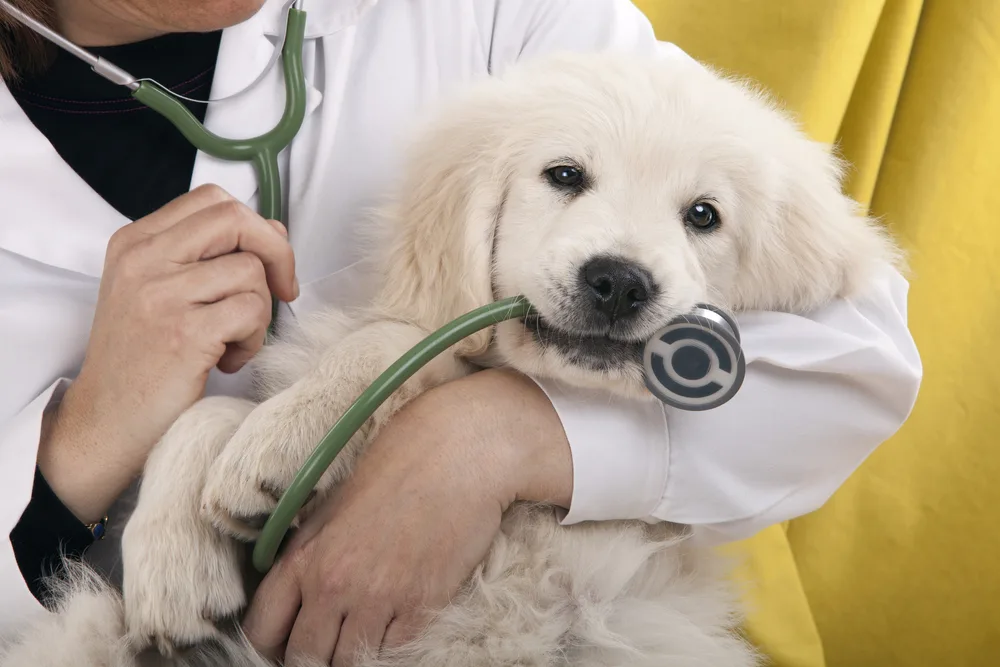Medically Reviewed by Dr. Majid Tanveer, DVM
Having a dog isn’t all cuddles and puppy kisses. Much of being a pet owner includes doing gross chores, like checking and cleaning up their poop.
Usually, dealing with stool is quick and easy. However, you might occasionally notice problems with your dog’s feces, like blood. A bloody stool can be scary, especially if you don’t know where it’s coming from.
Why is my dog pooping blood?
A stool with blood usually indicates a health problem. Some issues are mild and straightforward to solve, while others cause concern. If you ever notice your dog producing bloody fecal matter, you should talk to a veterinarian immediately.
Before panicking, learn what you need to know about bloody poop in dogs.
What Does Bloody Stool Look Like?
There are two types of bloody stool you should be aware of:
- Melena – Bright red blood in dog’s poop
- Hematochezia – Black and tarry poop
You can tell which one your dog is experiencing by looking at its color and consistency.
Your dog has melena if their poop looks black and tarry. The dark color comes from bleeding in the upper GI tract, like the stomach or intestines.
If your dog’s stool contains red blood, they are experiencing hematochezia. This is fresh blood from the lower GI tract, such as the colon, rectum, or anus.
Your dog’s stool can tell you much about his feelings. Dog owners need to pay attention to their pet’s poop since each type of bloody stool has a different cause.
4 Reasons Why Your Dog is Pooping Blood
As you can imagine, I saw a lot of bloody stool during my time as a veterinary professional. Puppy parents would rush into the clinic, worried sick about their fur babies. If your human child were pooping blood, you’d feel concerned, too!
There are many reasons why your dog could have bloody stools. The severity depends on several factors, including the type of fecal blood, length of time, and accompanying health concerns.
They Are Constipated

Have you ever noticed your pup straining to use the bathroom? If so, they’re likely experiencing constipation.
Dogs get constipated just as much as people do! When they’re finally able to have a bowel movement, you might see tinges of blood.
Some causes of canine constipation include a poor diet, age, or blockage. It could also point to deeper issues like an enlarged prostate or metabolic disease.
Usually, bloody stool with constipation occurs because of straining. Tiny tears in the rectum and anus may bleed when your dog is forcing a bowel movement. You’ll likely see hematochezia (bright red blood) if constipation is the problem.
They’ve Eaten Something Sharp
We all know that dogs eat things they shouldn’t. For example, dogs eat rocks, sticks, and other sharp objects.
Look at this table we built detailing all the weird things dogs consume regularly:
- Kid’s toys
- Coins
- Clothing / Fabric
- Stones
- Plastic bottle caps
- Cooked chicken bones
- Corn cobs
What goes in your pet’s mouth has to come out eventually. Often, passing a foreign body causes bloody stool. This happens when the object they eat is sharp and causes cuts anywhere in their GI tract.
If the cuts happen in the upper GI tract, the bloody stool will appear dark. If it occurs in the lower GI tract, your dog’s poop will have bright red blood.
They Have Allergies
Have you ever scratched yourself so hard you bled? The same thing can happen to your pup, too!
Skin allergies often cause your dog to bite and claw at their skin. If they do it hard enough, they may draw blood. When this happens around their anus or at the base of their tail, blood can appear in their poop.
If your dog licks his butt often, this could be a sign of skin allergies. Your furry friend could be allergic to environmental factors like grass or food proteins like chicken.
They may also have flea dermatitis, an allergic reaction to flea bites. Keeping up with monthly flea preventative is the best way to avoid this problem.
They Have a Medical Problem
Sometimes, bloody stool happens because of a more serious matter. Melena and hematochezia may be present in your dog’s poop because of a significant medical problem.
Gastrointestinal diseases are common dog health problems that often cause bloody stool. Illnesses like pancreatitis and stomach cancer cause bleeding in the GI tract that exits the body via bowel movements.
Your fur baby might also have bloody stool because of parasites! Hookworms, roundworms, and tapeworms mess with their digestive system and cause constipation, diarrhea, and other conditions that produce blood.
Monthly flea and parasite prevention will help you get this problem under control.
Another severe medical problem you need to know about is parvovirus. This illness is common in young puppies and causes several serious problems, including bloody diarrhea.
Parvo can kill a dog if you don’t treat it. Because of its severity, veterinarians recommend at least three boosters before your puppy is 24 weeks old. After that, yearly vaccinations will protect your dog from the virus.
To learn more, watch this video about parvovirus in dogs.
3 Ways To Solve The Problem

Finding blood in your dog’s stool is shocking and worrying. Your pet might also experience dehydration, vomiting, and depressed behavior, which always concerns attentive owners.
The good news is that there are ways to solve the problem. Don’t ignore your dog’s bloody poop; think about using these techniques.
Watch What They’re Eating
Since blood in your dog’s poop is usually a GI problem, you must watch what they eat. If your pooch is always constipated, you might need to feed them a better diet.
We recommend high-quality brands like Iams, Hill’s Science Diet, Royal Canin, and Purina. These dog food companies perform their research and feeding studies, so you always know what you’re giving your furry friend.
Sometimes, you need to give your dog’s digestive system a break. Some foods to feed your dog when they’re sick are gentle, allowing your pet’s body to heal.
Never leave sharp objects like rocks, sticks, glass, or plastic around an unsupervised dog. Ingesting a foreign body could cause extreme damage that requires surgery.
Try At-Home Remedies
You can try at-home remedies if you can’t bring your dog to the doctor.
Something to note: always consult a vet before fixing the problem yourself. Sometimes, veterinarians give phone advice if they don’t think the problem is too severe.
For example, bowel movement difficulties aren’t always significant problems in the early stages. Some remedies to relieve canine constipation are effective for minor issues. Offering your wet dog food instead of dry kibble could be just what they need to get things going.
Make sure your pup always has access to water. Dehydration is a significant GI problem concern and could worsen the situation.
Bring Them to a Vet ASAP
Of course, the best way to address blood in your dog’s poop is by talking to a veterinarian. You’ll never know if there’s a serious issue unless you get a professional opinion.
If the bloody stool is due to a bacterial infection, your dog will need medication only a vet can prescribe. They can also give them anti-diarrhea medicine or laxatives to ease any pain.
If your fur baby is also experiencing dehydration, they may need IV (Intravenous) fluids. The only safe way to get this treatment is through an experienced veterinarian.
Your vet can perform tests, suggest diet changes, and offer valuable professional advice.
FAQs
Is bloody stool in a dog an emergency?
While bloody feces is common, it’s never routine. Sometimes, it’s a small problem; other times, it’s serious. You should always seek veterinary help if you notice blood in your dog’s stool.
What should I do if there’s bloody poop and vomiting?
Call your vet ASAP. Check and see if they could have ingested something they weren’t supposed to. If you can’t see your veterinarian immediately, feed a bland diet and offer your dog plenty of water.
Is bloody stool a problem if they’re acting normal?
Yes! Bloody stool is still a problem, even if your dog behaves fine. Mild-tempered pets often hide their discomfort. Whether minor or significant, blood in your dog’s stool always has an underlying cause.
Bottom Line
The bottom line is that bloody stool is a common and concerning thing that happens to many dogs. However, common doesn’t mean normal!
Different kinds of bloody stools mean different things. Pay attention to your pet’s bathroom habits to narrow the problem down.
Your four-legged friend could experience blood in their poop for so many reasons! While some aren’t that concerning, others could be severe. Serious issues like cancer and parvovirus could be life-threatening.
You can help your paw-fact pal by changing their diet or trying home remedies. However, the best way to cure bloody stools is by making an appointment with your friendly neighborhood vet.
That’s all you need to know about why your dog is pooping blood! Even though it’s gross, getting help will give you more time to play and love your best fur friend.
